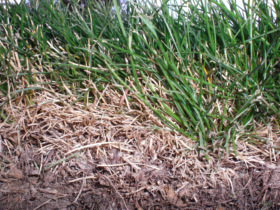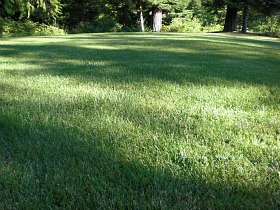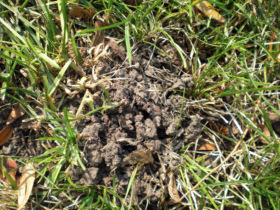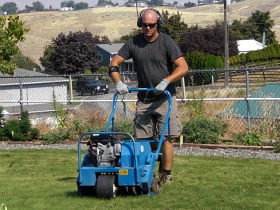Mechanical dethatching (power raking or vertical mowing) removes excess thatch buildup. However, it doesn’t fix the reasons your lawn produces too much thatch.

What is Thatch?
Thatch is an interwoven layer of decomposing grass roots, shoots and leaves that forms between the soil surface and the green top growth in established lawns. As grass sheds old roots, shoots and leaves it builds up faster than it rots…making a thatch layer.
A thatch layer is normal and can be beneficial or harmful…depending upon the amount present. Up to 1/2 inch is beneficial…over 1/2 inch needs to be addressed.
Some lawns never develop a thatch problem and others become thatch-bound quickly. Grass type and lawn care practices influence thatch buildup.

How to Keep Thatch in Check
- Avoid overwatering.
- Don’t bag your clippings.
- Use pesticides only as a last resort.
- Avoid over-fertilizing with nitrogen.
- Aerate and top-dress with compost to keep your soil ecosystem happy and healthy.
Thatch is Beneficial
Healthy lawns have a layer up to ½ inch thick.
It’s a dense and spongy cushion…
- Making your grass more resilient to wear and tear
- Protecting soil from compaction
It acts as a mulch…
- Helping the soil surface to retain moisture
- Stabilizing soil temperature
- Shades delicate grass parts (root system and grass crowns) from the summer sun
- Reduces soil erosion: preventing soil from washing away from roots in heavy rains
Promoting microbial activity…
- A lot of good microorganisms and bacteria reside in the decaying thatch layer.
- These microbes are an important part of the soil ecosystem.

Too Much Thatch (over ½ inch)…
- Prevents moisture, oxygen and nutrients from penetrating the soil.
- Creates a favorable environment for insects and disease.
- Very thick layers of thatch may cause scalping – uneven and difficult mowing.
- Makes your lawn less cold, heat, and drought tolerant.
A good way to determine your thatch depth is to remove a two-inch deep wedge from your lawn. If the thatch layer exceeds 1/2 inch, you should consider dethatching.
A thatch layer greater than 1/2 inch thick makes watering difficult since thatch dries out quickly and is difficult to re-wet. As it builds up, grass roots and crowns grow into the thatch layer making your lawn susceptible to heat, cold and drought stress.
Lawns Prone to Have Thatch Problems…
Thatch build-up varies among lawns. Some lawns never develop a thatch problem, while others become thatch-bound within a few years. Generally, the more aggressively grass is growing, the faster it will develop a thatch layer. Build-up happens when growth exceeds the rate of decomposition.
Aggressively spreading species such as bermudagrass and Kentucky bluegrass are heavy thatch builders. Tall fescue and perennial ryegrass have a low tendency to produce thatch.
Slower growers like zoysiagrass and fine fescues can form a dense thatch layer because their fibrous tissues resist decay.
Cultural Practices
Cultural practices can have a big impact on thatch.
Over-watering and over-fertilizing contribute to thatch buildup because they cause your lawn to grow excessively fast. Thatch is then made faster than it is decomposed.
Grasscycling – recycling grass clippings by leaving them on your lawn – does not cause thatch buildup. Clippings are very high in water content and decompose rapidly, recycling nutrients back into your lawn…you’ll have to fertilize less…
Natural Dethatching
Earthworms and microorganisms naturally reduce thatch. Earthworms dethatch lawns by their activity – they are constantly mixing organic matter on the surface and into the soil. Soil microbes use organic matter for food…breaking it down into humus.

Conditions that reduce the activity of critters decomposing organic matter…
- Using pesticides – especially insecticides or fungicides
- Compacted soils – soils with poor soil aeration
- Soil pH out of whack (7.2 or below 6)
Avoid indiscriminate use of pesticides. Many insecticides harm earthworms and fungicides reduce soil microbe populations. Pesticides should only be used after you have identified the cause of the problem and have determined it is necessary.
Aerating with a core aerator promotes better air, water and nutrient movement into the soil. It also brings soil to the surface mixing into the thatch layer. This stimulates microbial activity speeding up thatch decomposition.
Top-dressing with a thin layer (1/8 to 1/4 inch) of compost adds organic matter full of microorganisms.
Have your soil tested every couple of years. Follow the recommendations to correct soil pH.
Mechanical Dethatching – Power Raking
If you have a serious thatch problem, thatch can be removed with a power rake or vertical mower. These machines have steel spring-like or knife-like tines that rotate perpendicular to the ground. After mechanical dethatching, the cause should be addressed or your problem will likely return.
Mechanical dethatching is hard on lawns. It tears out grass along with the thatch. Therefore…the best time to dethatch is when conditions favor rapid recovery. Fall or early spring for cool-season grasses. Late spring (after green up) or early summer for warm season grasses.
Fall is the preferred time to dethatch because few weed seeds are sprouting. You can also follow up the process with overseeding and fertilizing to fill in thin areas.
Core aeration causes much less damage to existing turf than power raking or verticutting. Aerating at least once a year should keep thatch in check.

More Lawn Care Basics:
Best Lawn Fertilizer
How to choose the best lawn fertilizer. What do the numbers on the bag mean? Are organic fertilizers more eco-friendly than chemicals? Consider costs and nutrient needs. Are they pet-safe?
Lawn Mowing Tips | How to Mow Like a Pro
Lawn Mowing: Tips and techniques, the basics of lawn care. How to cut grass like a pro. Cutting grass to keep it looking groomed and healthy. DIY tips and advice for growing grass.
Lawn Fertilizer Calculator
Use this fertilizer calculator to determine the amount of granular fertilizer product that is needed to spread on your lawn according to recommended rates.
